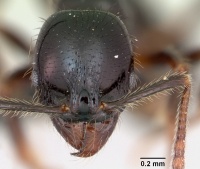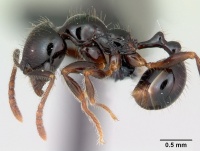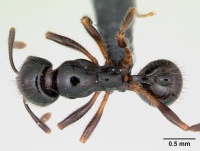Stenamma expolitum
| Stenamma expolitum | |
|---|---|

| |
| Scientific classification | |
| Kingdom: | Animalia |
| Phylum: | Arthropoda |
| Class: | Insecta |
| Order: | Hymenoptera |
| Family: | Formicidae |
| Subfamily: | Myrmicinae |
| Tribe: | Stenammini |
| Genus: | Stenamma |
| Species: | S. expolitum |
| Binomial name | |
| Stenamma expolitum Smith, M.R., 1962 | |
Stenamma expolitum is a specialist inhabitant of clay banks. It occurs from 50–1300 m elevation in mature wet forest environments. Nests are generally found in vertical clay banks along streams or cuts along trails (Branstetter, 2013).
Identification
Branstetter (2013) - Integument mostly black, with legs dark brown, changing to orange-brown only at extremities and joints; medium-sized species (see HL, ML, PrW below); petiole and postpetiole almost completely smooth and shiny, with only a few faint vestigial punctae sometimes present; postpetiole in profile bulging, globular, usually appearing more voluminous than petiolar node; face almost completely smooth and shiny, except for variable number of faint carinulae and punctae; promesonotum almost completely smooth and shiny; eye relatively large (EL 0.13–0.16, REL 18–21), oval-shaped, with 7–9 ommatidia at greatest diameter; anterior margin of clypeus with median emargination; basal margin of mandible straight; propodeal spines absent (PSL 0.12–0.14, PSI 0.9). Similar species: Stenamma atribellum, Stenamma alas, Stenamma expolitico.
Stenamma expolitum, along with S. alas and S. expolitico, belongs to the expolitum species group. This group is defined by the following: propodeal spines absent; petiole and postpetiole almost completely smooth and shiny, with only faint punctae sometimes present laterally; postpetiole in profile bulging, globular, appearing more voluminous than petiolar node; anterior clypeal margin with a median emargination; basal margin of mandible straight. Stenamma expolitum can be separated from other expolitum group species by its nearly completely smooth and shiny face. In the field, S. expolitum can be separated from S. alas by its nest structure (see biology section). Although they do not co-occur, S. expolitum looks superficially like Stenamma atribellum, which is restricted to Cusuco, Honduras. Both species have completely smooth sculpturing, but the latter species has the anterior constriction of the gaster distinctly elongate.
Keys including this Species
Distribution
Latitudinal Distribution Pattern
Latitudinal Range: 13.7695496° to 9.8712602°.
| North Temperate |
North Subtropical |
Tropical | South Subtropical |
South Temperate |
- Source: AntMaps
Distribution based on Regional Taxon Lists
Neotropical Region: Costa Rica (type locality), Nicaragua.
Distribution based on AntMaps
Distribution based on AntWeb specimens
Check data from AntWeb
Countries Occupied
| Number of countries occupied by this species based on AntWiki Regional Taxon Lists. In general, fewer countries occupied indicates a narrower range, while more countries indicates a more widespread species. |

|
Estimated Abundance
| Relative abundance based on number of AntMaps records per species (this species within the purple bar). Fewer records (to the left) indicates a less abundant/encountered species while more records (to the right) indicates more abundant/encountered species. |

|
Biology
Stenamma explolitum and Stenamma alas have nearly identical nesting ecology, with a few subtle differences. They nest in clay banks and have a nest entrance that is a turret of pebbles recessed in an alcove. S. expolitum constructs its nests with a vertical turret, rather than a horizontal one, and usually has two chambers. There is one main nest chamber extending back into the bank from the entrance, and a smaller secondary chamber above the first and with entrance in the alcove above and behind the turret. The queen and brood always occur in the main chamber. Colonies maintain two or three nests in active condition but only occupy one. A door pebble is used to close the entrance to the main nest chamber when army ants are present. Colony size is probably similar to S. alas, but so far, censused colonies tend to be smaller, with around 100 individuals. S. expolitum in Costa Rica seems to be abundant at very low elevations with S. alas more common around 300 m and higher. It also seems to be easier to find colonies of S. expolitum away from streams in trail cuts or in steep clay slopes, suggesting that the species may be more tolerant of drier substrates. (Longino 2005, Branstetter 2013)
Castes
Males have been collected but have not been described.
Nomenclature
The following information is derived from Barry Bolton's Online Catalogue of the Ants of the World.
- expolitum. Stenamma expolitum Smith, M.R. 1962a: 36 (w.q.) COSTA RICA, NICARAGUA.
- Type-material: holotype worker, 12 paratype workers, 1 paratype queen.
- Type-locality: holotype Costa Rica: Santa Clara Prov., Colombiana Farm, iii.-iv.1924 (W.M. Mann); paratypes with same data.
- Type-depositories: USNM (holotype); AMNH, MCZC, USNM (paratypes).
- Branstetter, 2013: 111 (m.).
- Status as species: Kempf, 1972a: 242; Bolton, 1995b: 393; Branstetter, 2013: 108 (redescription).
- Distribution: Costa Rica, Nicaragua.
Unless otherwise noted the text for the remainder of this section is reported from the publication that includes the original description.
Description
Worker
Branstetter (2013) - (10 measured) HL 0.75–0.93, HW 0.66–0.83 (0.82), FLD 0.20–0.23 (0.23), PCW 0.05–0.08 (0.06), SL 0.63–0.78 (0.76), EL 0.13–0.16 (0.16), ACL 0.63–0.74 (0.73), ML 1.02–1.26 (1.26), PrW 0.51–0.62 (0.61), PSL 0.12–0.14 (0.13), SDL 013–0.15 (0.14), PL 0.39–0.47 (0.47), PH 0.21–0.27 (0.26), PW 0.15– 0.19 (0.18), PPL 0.24–0.30 (0.27), PPH 0.20–0.25 (0.24), PPW 0.19–0.24 (0.23), MFL 0.74–0.95 (0.91), MTL 0.58–0.75 (0.73), CI 87–92 (92), SI 91–96 (92), REL 18–21 (19), FLI 27–30 (28), PSI 0.9 (0.9), MFI 85–91 (90), ACI1 60–65 (64), ACI2 92–101.
Medium-sized species; general body color black to dark red-brown, with patches of dark brown on gaster; appendages mostly dark brown with joints and extremities a lighter orange-brown; setae dark golden brown; mandible usually with 6–7 teeth, consisting of 4 distinct apical teeth, a distinct basal tooth, and 1–2 inner teeth/denticles, which are usually worn and indistinct; basal margin of mandible straight, without a basal notch or depression; mandible surface mostly smooth and shiny, with scattered piligerous punctae and a few faint striae; anterior clypeal margin with median emargination; median lobe of clypeus obliquely flattened, mostly smooth and shiny, except for transverse carinula near anterior margin, remainder of clypeus mostly smooth and shiny; posterior extension of clypeus between antennal insertions somewhat wide (PCW 0.05–0.08), with sides subparallel to slightly diverging posteriad; frontal lobes of moderate width (FLD 0.20–0.23, FLI 27–30), not covering torular lobes in full-face view; head roughly oval-shaped (CI 87–92), with posterior margin flat, not de-pressed medially; eye relatively large (EL 0.13–0.16, REL 18–21), oval-shaped, with 7–9 ommatidia at greatest diameter; face completely smooth and shiny, except for variable number of very faint carinulae extending from frontal lobes to about mid-point of head, a few carinulae on gena, and scattered piligerous punctae; scape of moderate length (SI 91–96), usually reaching posterior margin of head when laid back; scape surface mostly smooth and shiny, with scattered piligerous punctae; funiculus with distinct 4-segmented antennal club; mesosoma almost completely smooth and shiny, except for transverse carinulae on propodeal dorsum, carinae along metanotal grove, and a few scattered rugulae and piligerous punctae; metanotal grove somewhat shallow and wide; propodeal dorsum in profile flat to distinctly convex; propodeal spines absent, at most forming nearly imperceptible nubs (PSL 0.12–0.14, PSI 0.9); petiole of moderate length (PL/HW 0.53–60); petiolar node in profile robust (PH/PL 0.54–0.60), wedge-shaped, with the anterior face long and sloping and the posterior face shorter and nearly vertical; node dorsum rounded, pointing vertically or slightly posteriad; petiolar node in profile robust, more globular than petiolar node, but similarly asymmetrical with long anterior face and short vertical posterior face; petiole and postpetiole mostly smooth and shining, with a few vestigial punctae; gaster smooth and shiny, with only scattered piligerous punctae; most of body dorsum with long standing pilosity; scape setae suberect to subdecumbent; setae on gastral tergites long, sparse, and uniformly suberect; setae on legs suberect to subdecumbent, with longer suberect setae on coxae and femoral venters.
Queen
Branstetter (2013) - (5 measured) HL 0.87–0.96 (0.90), HW 0.78–0.87 (0.81), FLD 0.24–0.27 (0.25), PCW 0.07–0.08 (0.07), SL 0.72–0.79 (0.76), EL 0.21–0.23 (0.23), ACL 0.70–0.77 (0.71), ML 1.23–1.43 (1.32), PrW 0.67–0.78 (0.74), PSL 0.11–0.15 (0.15), SDL 0.13–0.15 (0.15), PL 0.48–0.53 (0.48), PH 0.27–0.31 (0.29), PW 0.19–0.23 (0.21), PPL 0.30–0.33 (0.30), PPH 0.26–0.30 (0.29), PPW 0.26– 0.30 (0.27), MFL 0.87–1.00 (0.93), MTL 0.67–0.79 (0.74), CI 90–92 (90), SI 91–93 (93), REL 26–28 (28), FLI 30–31 (30), PSI 0.9–1.0 (1.0), MFI 86–90 (87), ACI1 60–61 (60), ACI2 94–103 (94).
Same as worker except for standard queen modifications and the following: facial sculpture more developed, with distinct carinulae extending from frontal lobes to ocelli, and some carinulae on gena; pronotum with transverse striae near posterior margin; posterior third of mesoscutum with variable amount of striae/costae, orientation variable, most often longitudinal, but sometimes transverse, or obliquely angled mesad toward posterior margin; scutellum with variable number of longitudinal costae; propodeum with more distinct transverse carinae that extend across the dorsum to upper half of side; wing venation as in specimen JTLC000005582.
Type Material
Branstetter (2013) - Holotype worker: COSTA RICA, Santa Clara [Limón] Province: Colombiana Farm, [ca. 10.167°N, 83.583°W], March- April 1924 (W. M. Mann) (USNM, Type No. 65967).
References
- Branstetter, M. G. 2012. Origin and diversification of the cryptic ant genus Stenamma Westwood (Hymenoptera: Formicidae), inferred from multilocus molecular data, biogeography and natural history. Systematic Entomology 37:478-496. doi:10.1111/j.1365-3113.2012.00624.x.
- Branstetter, M.G. 2013. Revision of the Middle American clade of the ant genus Stenamma Westwood (Hymenoptera, Formicidae, Myrmicinae). ZooKeys 295, 1–277. doi:10.3897/zookeys.295.4905
- Longino, J. T. 2005. Complex nesting behavior by two Neotropical species of the ant genus Stenamma (Hymenoptera: Formicidae). Biotropica 37(4): 670-675 (page 670, see also)
- Smith, M. R. 1962a. A remarkable new Stenamma from Costa Rica, with pertinent facts on other Mexican and Central American species (Hymenoptera: Formicidae). J. N. Y. Entomol. Soc. 70: 33-38 (page 36, worker, queen described)
References based on Global Ant Biodiversity Informatics
- Branstetter M.G. 2013. Revision of the Middle American clade of the ant genus Stenamma Westwood (Hymenoptera, Formicidae, Myrmicinae). ZooKeys 295: 1277
- Fernández, F. and S. Sendoya. 2004. Lista de las hormigas neotropicales. Biota Colombiana Volume 5, Number 1.
- Kempf, W.W. 1972. Catalago abreviado das formigas da regiao Neotropical (Hym. Formicidae) Studia Entomologica 15(1-4).
- Longino J. T. L., and M. G. Branstetter. 2018. The truncated bell: an enigmatic but pervasive elevational diversity pattern in Middle American ants. Ecography 41: 1-12.
- Longino, J.T. 2005. Complex Nesting Behavior by Two Neotropical Species of the Ant Genus Stenamma (Hymenoptera: Formicidae). Biotropica 37(4):670-675
- Smith M. R. 1962. A remarkable new Stenamma from Costa Rica, with pertinent facts on other Mexican and Central American species (Hymenoptera: Formicidae). Journal of the New York Entomological Society 70: 33-38.

